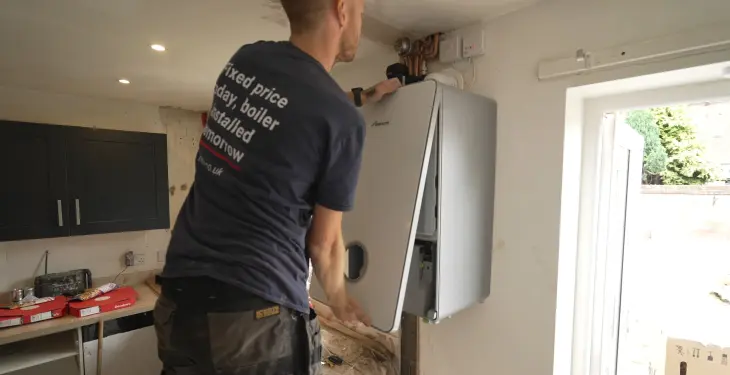

Written by Stephen Day
Gas Safe Engineer
Updated: 16th October, 2025
Radiator efficiency plays a key role in maintaining a comfortable and cost-effective home. Efficient radiators heat rooms more evenly, ensuring a consistent temperature. This reduces the need to keep adjusting the thermostat.
Get a new boiler quote, save up to £550 per year (0% APR available).
In the UK, where winters often bring biting cold, radiator efficiency is essential to keep homes warm and energy costs down. As energy prices soar and the cost of living rises, optimising radiator performance can make a significant difference. Simple changes can maximise warmth and keep bills manageable.
Radiators, a vital part of a central heating system, require regular maintenance for optimal performance. Dust and sludge can hinder operation, leading to inefficient heat distribution. From cleaning to strategically placing radiators, small actions can have a substantial impact. Installing thermostatic radiator valves can further enhance efficiency by managing the temperature in each room.
With a few straightforward adjustments, homeowners can ensure their heating systems operate at peak performance throughout the winter. Some things to consider include regular bleeding of radiators and keeping them free from blockages. As a result, homes can maintain a comfortable temperature without spiking energy bills.
Get a quote in 60 seconds, fitted as fast as next day!
0% APR finance available.
Radiator efficiency plays a key role in maintaining a comfortable and cost-effective home. Efficient radiators heat rooms more evenly, ensuring a consistent temperature. This reduces the need to keep adjusting the thermostat.
Lowering energy usage is another benefit. Efficient radiators help homeowners save on energy bills. With energy prices rising, optimising heating systems can significantly decrease costs.
An efficient heating system also benefits the environment. By using less energy, efficient radiators produce fewer emissions. This helps lower the household's carbon footprint and supports eco-friendly living.
Health impacts should not be overlooked. Efficient systems reduce harmful by-products, like carbon monoxide. A well-maintained radiator ensures a clean and safe indoor environment.
Lastly, longevity is a consideration. Radiators with better efficiency experience less wear and tear. This means a longer lifespan for the heating system, providing value over time.
Enhanced comfort, financial savings, and environmental awareness make radiator efficiency a vital aspect of home heating.
Improving radiator efficiency can make a noticeable difference in home heating. One effective way is regular cleaning. Dust and dirt can accumulate, reducing heat transfer. A clean radiator allows for better convection, enhancing heat circulation.
Radiator reflectors are another useful method. By placing them behind radiators, they reflect heat back into the room rather than letting it escape through walls. This helps in reducing heat loss.
Checking for cold spots is crucial. If the bottom of a radiator is cold while the top is hot, it may need flushing. Flushing removes debris buildup, improving overall performance.
Bleeding radiators is a simple task. Trapped air in radiators can prevent them from heating properly. Bleeding lets out this air, ensuring even heat distribution.
Balancing radiators is also important. This ensures that each radiator gets the right flow of water, leading to consistent heat throughout the home. It's a straightforward process that can have a significant impact.
Enhance performance by improving home insulation. Adding insulation to walls and floors can reduce heat loss, making radiators more effective. This step maximises heat retention, increasing comfort.
These simple steps can significantly enhance radiator efficiency. Regular maintenance and small adjustments lead to better heat transfer and circulation, making homes warmer and more energy-efficient.
To improve radiator performance, regular maintenance is key. Checking the boiler pressure ensures the system runs efficiently. Boilers set at the right pressure distribute heat more effectively.
Flushing radiators can remove built-up debris or sludge. A sign of this need is cold spots at the bottom with warmth at the top. This task may involve using a hosepipe or pressure washer to clear internal blockages.
Keeping radiators clean enhances their efficiency. Dust acts like insulation, reducing heat output. Using a hairdryer can help blow out dust from hard-to-reach areas behind radiators. This simple step ensures radiator surfaces remain free from dust.
Beyond cleaning, rearranging furniture is also important. Ensure there’s no blockage in front of radiators. This allows air to circulate freely, helping to heat the room more evenly.
For more advanced steps, consider bleeding radiators. If parts of a radiator remain cool, trapped air could be the cause. Bleeding removes this air, allowing water to fill the radiators completely, boosting their performance and efficiency.
Keeping radiators efficient is crucial for reducing heating costs and lowering energy bills. A few straightforward actions can make a significant difference in performance.
Regular Cleaning
Dust and dirt on radiators act as insulation, reducing heat output. Regular cleaning enhances energy efficiency.
Use Radiator Reflectors
Radiator reflectors help direct heat back into the room instead of losing it through walls. This simple addition can improve heating efficiency.
Bleed Your Radiators
Trapped air can cause radiators to heat unevenly. Bleeding them releases air, ensuring they heat evenly and more effectively.
Flushing Radiators
Over time, sludge can build up inside radiators, impeding warmth distribution. Flushing removes this issue, allowing for more efficient radiators.
Adjust Thermostatic Valves
Installing and adjusting thermostatic radiator valves can help control room temperatures, optimising electric heating use.
These steps not only improve radiator performance but also lead to more sustainable energy usage. By keeping radiators running efficiently, homes can stay warm and energy usage stays manageable. Simple, effective steps ensure a cosy and efficient home environment.
Bleeding radiators is essential for maintaining heating efficiency. Over time, air can become trapped in radiators, creating cold spots that prevent hot water from circulating effectively. This trapped air hinders performance, causing uneven heating and increased energy bills.
Bleeding radiators is a simple process that involves releasing the air. This allows water to fill the entire radiator, ensuring that heat is distributed evenly. For many radiators, a radiator key is used to open the valve, releasing the air.
Steps to Bleed a Radiator:
Turn off the heating and let the radiators cool.
Use a radiator key or flat-head screwdriver on the bleed valve.
Hold a cloth beneath the valve to catch any drips.
Turn the key until you hear a hissing sound.
Once water starts to flow steadily, close the valve.
This task is recommended during warmer months when the heating is off, as it provides a convenient and safe time to perform the procedure.
Bleeding radiators not only ensures consistent warmth throughout a space but also helps save on energy costs. Radiators function more efficiently, meaning less energy is needed to achieve desired temperatures.
In summary, regular maintenance like bleeding can significantly enhance radiator performance. By removing air pockets, the heating system works optimally, providing both comfort and cost savings.
Regular maintenance is key to keeping radiators working efficiently. Balancing radiators ensures even heat distribution throughout the home. This involves adjusting the flow of water to each radiator, so they all heat up evenly.
Cleaning radiators regularly removes dust and dirt. Dust can act as an insulator, trapping heat that should be circulating through the room. Use a vacuum with a brush attachment to get into hard-to-reach areas.
Checking each radiator for cold spots can indicate the need for bleeding. If the top of the radiator is cold but the bottom is warm, trapped air might be the issue. Bleeding allows air to escape, enabling better water flow and heat distribution.
Flushing the system every few years is another important task. Over time, radiators can accumulate debris and sludge. This build-up affects efficiency by blocking pathways for hot water.
Look out for leaks or corrosion, as these can signify bigger problems down the line. Regular inspections can spot these issues early, reducing the risk of costly repairs.
Lastly, ensuring there are no obstructions in front of or above the radiators is important. Clear pathways for heat improve circulation and prevent unnecessary strain on the heating system.
Implementing these maintenance tasks can lead to improved radiator performance, helping homes stay warm and energy-efficient.
Radiator valves play a key role in enhancing the efficiency of heating systems. They control the amount of hot water that enters a radiator, allowing it to heat up the room effectively. By adjusting these valves, users can manage temperature more accurately and save energy.
One type of valve, the thermostatic radiator valve (TRV), is especially useful. TRVs automatically adjust the flow of hot water based on the room's air temperature. This precise control helps in maintaining desired comfort levels without wasting heat.
Zonal heating becomes possible with radiator valves. Zonal heating allows different rooms to be heated at different times or temperatures. This is ideal for large homes or spaces where certain areas are used more often than others.
By setting each TRV according to the needs of the room, one can avoid unnecessary heating. For example, bedrooms can be kept cooler than living areas. This approach not only saves energy but also reduces heating costs.
Valves come in various styles such as angled or straight, to suit different piping arrangements. Choosing the right valve type ensures the heating system operates smoothly and economically.
Effective use of radiator valves contributes to a more energy-efficient home. It helps in achieving the perfect balance between comfort and cost, making it a valuable addition to any modern heating system.
When radiators don't heat properly, the cause might be straightforward. Air trapped in the radiator can be a major issue. This trapped air prevents hot water from circulating efficiently. Bleeding the radiator is a simple fix. Use a radiator key to release the trapped air until you hear a hissing sound.
Uneven heating is another common problem. This often means sediment or sludge has built up. Sludge blocks the flow of water, leading to cold spots. A power flush can remove these blockages and restore proper flow. It’s often best to get a professional to handle this procedure.
Faulty valves can also disrupt heating. Check if the valve is stuck or partially closed. If so, gently turn it a few times to free it up. If this doesn't help, replacing the valve might be necessary.
Another often overlooked factor is the boiler pressure. An incorrect pressure level can cause inefficiencies. The optimal range is usually between 1 and 1.5 bars. If the pressure is too low or high, adjusting it can improve performance. Check the boiler manual for guidance on how to do this safely.
For multiple issues or complex problems, consulting a professional might be the best route. They can diagnose and fix problems that are difficult to handle on your own. This ensures safe and efficient operation of your heating system.
Installing thermostatic radiator valves (TRVs) is a smart way to enhance energy efficiency in homes. These devices control the temperature of individual radiators, allowing rooms to be heated only when necessary.
TRVs automatically adjust the flow of hot water into a radiator based on the room's temperature. This means less energy is used if the room is already warm.
Benefits of TRVs:
Cost Savings: They reduce energy consumption, which can lower heating bills.
Comfort Control: Different rooms can have different temperatures, improving comfort.
Easy Installation: With quick setup, they are user-friendly and can be installed without extensive modification.
Smart Thermostats & TRVs
Smart thermostats work well with TRVs. They learn the heating preferences of the home and adjust the system accordingly. This combination maximises the potential savings and comfort.
Key Features:
Responsive Sensors: TRVs respond swiftly to temperature changes.
Zoned Heating: Allows for precise temperature control in each room.
Energy Efficiency
Studies suggest that TRVs can reduce energy use by around 5%. Combined with smart thermostats, these savings can be even more significant. It makes them a sensible upgrade for anyone looking to cut down on energy consumption.
In conclusion, TRVs represent a practical and efficient solution for energy conservation in domestic heating systems.
Radiators can experience efficiency problems due to build-up and blockages inside them. Sludge and debris can settle at the bottom, reducing heat distribution.
Regular cleaning is essential. Use a duster or vacuum cleaner to remove dust and dirt from the radiator's surface.
Bleeding radiators once a year helps release trapped air. This process is simple and requires a radiator key. Turn the key until you hear a hiss, and then close it when water starts to leak.
Regular system flushing is important. Professional power flushing every 3-5 years can help prevent sludge build-up.
Installing radiator reflectors can improve heat efficiency by reflecting heat back into the room. This reduces energy lost through walls.
Consistently checking boiler pressure can prevent problems. Make sure the pressure is at the recommended level for your system.
Annual servicing of your heating system helps maintain radiator efficiency. A professional can inspect for any hidden issues.
Combining these practices helps maintain radiator efficiency and ensures consistent heating throughout the home.
Cleaning your radiators is a simple and effective way to improve their efficiency. Dust and dirt can hinder heat distribution, making your room feel colder even when the radiator is on.
Steps to Clean Your Radiators:
Turn Off the Radiator: Ensure it's cool before cleaning to avoid burns.
Dust the Surface: Use a microfibre cloth or a duster to wipe the front panel. This helps remove dust and keeps the exterior clean.
Clean Between the Fins: For a deeper clean, a radiator brush or a slim tool is very useful. Dip it in warm soapy water and slide it between the fins to remove trapped dust.
Rinse and Dry: Wipe down with a clean, damp cloth, and then use a dry cloth to absorb any moisture.
Vacuum the Area: Use a vacuum cleaner with a nozzle attachment to gather any dust that might have fallen on the floor.
Extra Tips:
Regular cleaning can prevent dust build-up.
Cleaning twice a year can maintain optimal efficiency.
Keep the radiator area clutter-free to allow better airflow.
These steps help ensure your radiators work efficiently, providing warmth throughout your home. Regular maintenance can also extend the life of your radiators.
Correct radiator placement plays a vital role in improving heat efficiency and comfort. For horizontal radiators, placing them on the coldest wall typically allows them to counteract cold air more effectively. This strategic placement ensures warmth spreads evenly across the room.
Vertical radiators are ideal for narrow spaces or rooms with limited wall space. When installed in the right location, they can maximise heat output while using less wall area. It's crucial to avoid placing radiators behind large furniture or curtains that can block airflow.
Proper clearance around radiators is also essential. There should be at least 6 inches of space on all sides. This allows for unobstructed airflow, enhancing the radiator’s efficiency in circulating heat throughout the room.
In kitchens or areas with high moisture levels, positioning radiators away from damp walls can prevent deterioration and maintain efficiency. Radiators in these areas need to be placed where they can distribute heat effectively without interference.
Where possible, radiators should not face directly towards doors or windows, as heat loss can be significant. Instead, sidewall placement helps keep heat contained within the room.
With careful planning and the right placement, radiators can significantly improve a home's comfort and energy efficiency, ensuring they work optimally year-round, no matter how cold.
Get a quote in 60 seconds, fitted as fast as next day!
0% APR finance available.
Last updated: 16th October, 2025

Written by Stephen Day
Gas Safe Engineer at iHeat
Stephen Day is a Gas Safe registered and FGAS certified engineer with over 20 years of hands-on experience in the heating, cooling, and renewable energy industry, specialising in boiler installations, air conditioning, and heat pump systems.
LinkedInArticles by Stephen Day are reviewed by iHeat’s technical team to ensure accuracy and reliability.

22nd December, 2025
Based on data from over 7000 boiler installations completed by iHeat in the past 12 months...
 Read Article
Read Article

22nd December, 2025
Here’s a quick roundup of the best combi boilers for 2026.
 Read Article
Read Article

22nd December, 2025
When your old boiler breaks down and it comes time to replace it with a new one, it might...
 Read Article
Read Article
No obligation. Takes less than 60 seconds.